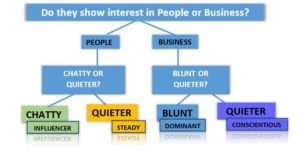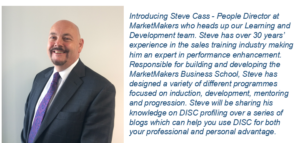Speed reading DISC profiles
OK, so it’s time for another delve into the world of DISC. In the last few weeks we have been exploring different facets of each DISC profile, including what it means to us as individuals. What we do well, what we need to focus on to develop further and how we can use DISC profiling to increase our impact on the people around us.
So, this time round we are going to learn how we determine each person’s DISC profile. Once we can do this we can start to adjust our language and behaviours and let our new DISC skills do their work, letting the results roll in!
The key to speed reading is to consider the different ways in which we communicate with people around us. There are three main ways in which we communicate: verbally, through body language and also, personal space.
When I’m speed reading profiles I also use a couple of other factors to ‘back-up’ my conclusions – these other areas are; the way they shake my hand and what their workspace looks like. We’ll get to these shortly but first let’s start with verbal as this often gives away a person’s DISC profile very quickly. What we need to look out for is the quantity and content of speech.
If on the initial meeting they seem interested in the social aspects of life or show interest in me or my team then they fall into one of two categories; Influencer or Steady. If, however, they are more formal and more interested in the business side of life then they are far more likely to be Dominant or Conscientious. To narrow it down to one out of the two profiles, you then need to focus on the quantity of speech. The Influencer will be very talkative and chatty, and quite possibly dominate the conversation. The Steady person will not try to dominate the conversation and is likely to be quieter.
Meanwhile the Dominant person will want to get to the point and likely look to control the conversation whereas the Conscientious person will initially remain much quieter. You will find that the Conscientious person is likely to seek detail and ask probing questions later in the conversation, just not in the early stages.
An easy breakdown of this technique is as follows:

I mentioned earlier that there are three ways we communicate with, the first was verbal, i.e. the words and subjects we talk about, and the second was through our body language. Well I’ve been banging on about DISC profiles for several weeks now let’s see if you can work out how to recognise each profile via their body language…
Question 1
Who is most likely to smile and greet you warmly at the first meet?
Question 2
Who is most likely to give you a very firm and confident handshake?
Question 3
Who is least likely to give you a hug on meeting?
Question 4
Who is likely to give you a gentle handshake on first meeting?
Drumroll please…..and the answers are;
Question 1 – Influencer
Question 2 – Dominant
Question 3 – Conscientious
Question 4 – Steady
I wonder how you got on?
Well to be fair using body language and handshakes can be a little misleading as many people may have been given feedback about their handshake, for example they may have been told to “reign it in a bit and not try to crush somebody’s hand!”, or perhaps “stop having a handshake like a wet lettuce!”, or even “please just shake hands and do not go for the full on hug!”.
Because of such feedback an individual may have practised their handshake to appear professional and assertive. Even so the Influencer will be the most tactile of the four profiles and the Conscientious person is the least tactile, in fact if they can get away with the handshake they will, so the Conscientious handshake will often be brief.
Let’s consider how each profile uses ‘personal space’…
So I would like you to picture a meeting room with a large boardroom style table in it. OK, now think about where each DISC profile is likely to sit. OK, got the picture in your mind? Let’s see how it worked out…
The Dominant person is likely to sit at the head of the table; they may even use their personal space to increase their ‘power’ and possibly stand. The Influencer will sit in the most central place where they can essentially be at the heart of things. The Steady person will sit next to somebody they know, or may even wait to be told where to sit and the Conscientious person is likely to sit in the least domineering position (i.e. not head of the table or the centre of either side).
Once again, always be aware that potentially anybody may have received feedback on how they use their personal space and this may cause them to change their natural choice of where to sit. Although in my experience, I have often found time and time again people have conformed to their DISC profile and it is actually quite useful for speed reading a profile.
Finally, another way of understanding an individual’s DISC profile is to think about their ‘work space’…
Firstly, the Dominant person’s office will ooze the message of power, perhaps a larger or different chair than others. Next up is the Influencer and you may find it difficult to open the door here because it will be cluttered and ‘organic’ (being an Influencer myself I don’t like to think of myself as messy as I usually know where everything is so ‘organic’ has a nice ring to it!), also you are likely to see motivational statements and posters around. The Steady person’s office will be homely and comfortable, look out for personalisation i.e. family photos, personalised mug with the family puppy on it, etc. Meanwhile, in the Conscientious office don’t be surprised to see planners, flow-charts and graphs.
So, next time you are walking around your own business environment see how many people’s office and workspace conforms to their DISC profile – have fun working it out! Next time we’ll look at how we can tailor sales presentations using DISC profiling.
Cheerio, I’m off to tidy up my office and have a chat, damn, I’ve just confirmed to my profile again!
See you next time.
Tags: B2B Marketing, Coaching, DISC, DISC Profiling, Learning and Development, Profiling, Training

